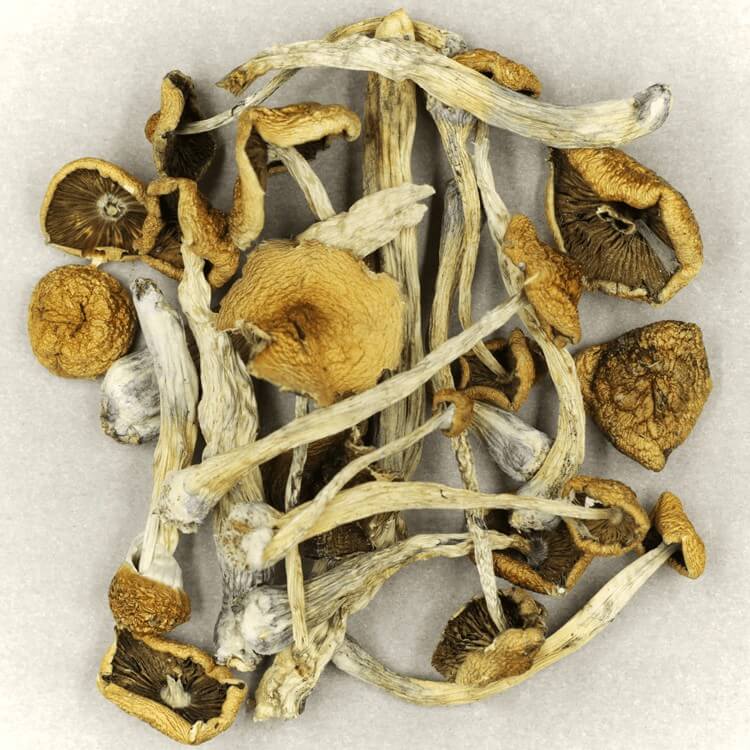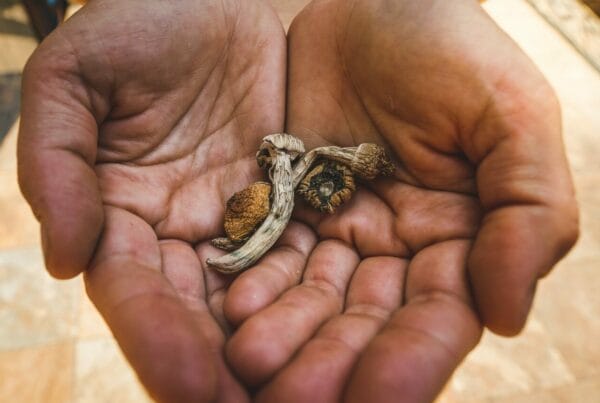Once thought to be a figment of imagination, the strength of Psilocybe mexicana is now being recognized due to ongoing psilocybin research. The psychedelic research sector consistently uncovers its therapeutic potency, slowly steering its acceptance within the medical community. Experts are excited by this developing area and are working tirelessly to determine safe dosage levels for therapeutic use.
Key Takeaways
- Researchers are utilizing innovative techniques such as liquid chromatography in conjunction with tandem mass spectrometry to evaluate the potency of mushrooms.
- Clinical trials are currently examining Psilocybe Mexicana among other mushroom species for potential therapeutic applications.
- The genetic variability in magic mushrooms plays a crucial role in constructing an accurate dosage chart.
Psychedelic Mushrooms: Transitioning from Unknown to Research Milestones
Historically, only a limited number of conditions were known to benefit from Psilocybe Cubensis. However, psilocybin is now making remarkable progress in discovering its concealed medicinal properties.
Researchers are capitalizing on the potential of Psilocybe Mexicana and other potent strains for clinical studies and thorough research. Regardless of whether the subjects are in vivo or in vitro, this strain proves effective in demonstrating the genuine effects and benefits of this fungal species.
Psychedelics Penetrating the Market
What was once concealed is now becoming transparent—continuous advancements and discoveries are capturing public attention, especially those seeking therapeutic solutions. Conventional mental health treatments often fail to deliver, leading individuals to explore more effective alternatives.
Enter the world of magic mushrooms.
Patients struggling with mental health conditions are increasingly turning to psilocybin, which has demonstrated potential in treating depression, alcohol dependency, anxiety, compulsions, tics, chronic pain, among others.
Currently, medical professionals are investigating creative ways to accurately determine the ideal dosage for safe patient administration. Notably, a research team from the University of Texas has created a model to extract psilocybin and psilocin concentrations.
It’s feasible to clinically ascertain the potency of magic mushrooms.
Distinctive Traits of Mexicana
Golden Teachers, Blue Meanies, and B-Plus are among the species of magic mushrooms that have been thoroughly researched. However, to deepen our knowledge on the safe usage of these mushrooms, it’s vital to investigate other species as well.
The Mexicana species is gaining popularity in the research field. This is not only due to its status as one of the oldest species, but also because its comparatively low potency increases its chances of conforming to medical drug standards.
Though this Mexican variant has a less powerful potency than other species, it’s capable of generating effects similar to those of mainstream strains. With the rising trend of microdosing among patients, this strain proves to be an excellent option.
The Mexicana species exhibits consistent levels of psilocybin and psilocin, much like other strains. So, why choose this over other similar strains? The answer lies in its historical and anthropological significance.
Delving Into a Rich “Mexican” History
In the past, psilocybe mexicana naturally sprouted in moss. Indigenous communities highly respected these psilocybin mushrooms for their multifaceted uses, often related to spiritual or supernatural phenomena.
Let’s focus on Mexican mushrooms. More than 2000 years ago, the earliest documented use of these mushrooms was by the native peoples of North and Central America. The Aztecs, an ancient civilization, referred to these mushrooms as the “food of the Gods,” or “teonanácatl” in their native language.
If the Aztecs were present today, they would vouch for the transformative, emotionally impactful, and mentally grounding effects of the Mexicana—despite being unfamiliar with these contemporary terms.
Despite diverse cultivation techniques, this mushroom has managed to retain its natural psilocybin concentrations, demonstrating its authenticity. This authenticity is a widely recognized standard that is highly valued by researchers and psychedelic research institutions.
Innovative Strategies for Psilocybin Content and Potency Testing
A team of ten researchers from the University of Texas at Arlington along with other research institutions have devised a new method for testing the potency of psychoactive compounds in mushrooms. This novel measurement pattern integrates liquid chromatography and tandem mass spectrometry.
Below are two pioneering techniques:
- Liquid chromatography is a technique that divides and examines chemical compounds. It’s employed here to study the active substances in mushrooms. The procedure involves running a liquid sample through a column packed with a solid substance (the stationary phase). Each chemical in the sample interacts differently with the stationary and mobile phases, resulting in their separation at varying speeds as they travel through the column.
- Spectrometry typically investigates the interaction of matter with electromagnetic radiation across a range of wavelengths. It identifies and measures substances according to the specific wavelengths of light that molecules absorb and disperse. This permits the determination of the electronic, vibrational, and rotational states of the chemical.
This approach was utilized on five varieties of magic mushrooms. The researchers found that the average total levels of psilocybin and psilocin across these varieties ranged from 0.879 to 1.36. These concentrations exceeded those found in many other strains, such as Bull Run and Cambodian. The accuracy of the study was confirmed by comparing the results with those from other independent labs.
The coherence of results between the two labs further affirmed the credibility of the testing procedure to precisely measure the strength of the mushrooms.
If this is validated by specialists, it could pave the way for new testing techniques for psychedelic potency, acting as an additional safeguard against unsafe dosage determinations.
Expanding Research to Other Varieties
Extending research to other mushroom species is advantageous. It can improve our knowledge of the health benefits correlated with different strains and provide essential data on the effects of less potent mushrooms.
Furthermore, it can assist in educating people about the influence of different dosages on the psychedelic experience. By comparing Mexicans with stronger strains like Psilocybe Cubensis, researchers can understand how different levels of active compounds can affect therapeutic outcomes.
For example, the Blue Meanies strain induces more intense hallucinogenic effects, which could potentially be beneficial in treating conditions like depression. On the other hand, strains with lower doses are more suitable for microdosing or subtle applications such as mood enhancement or improving focus.
Genetic Diversity Leads to Safer Treatments
It is often overlooked that different breeds or varieties have their unique genetic profiles and
Understanding the diverse characteristics and effects of hallucinogenic mushrooms like their strength and chemical composition is vital for medical professionals. It allows them to select the most suitable type for specific medical applications, and design doses according to individual requirements, thereby maximizing the benefits and minimizing the risks.
Let’s take Psilocybe Semilanceata (Liberty Caps) or Psilocybe cyanescens as examples. These strains have distinctive alkaloid profiles that may be effective for treating anxiety. On the other hand, synthetically grown mushrooms might be more appropriate for handling substance abuse or compulsive behaviors. This diversity enables the development of personalized treatments with enhanced safety and effectiveness.
We can infer that the genetic diversity in hallucinogenic mushrooms, coupled with advanced techniques for strength evaluation and identification, is key to creating safer medical treatments.
Enhanced Safety in Medical Application
Let’s contemplate the benefits of safer dosage administration.
- Decreased likelihood of overdosing: Accurate dosages eliminate the concern of overdosing. It also necessitates clearer product labeling to avoid consumer misunderstanding.
- Increased predictability: With accurate dosages, users can better predict the effects or experiences they may encounter, reducing overwhelming sensations and anxiety, and increasing patient satisfaction.
- Uniform measurement: Accurate dosages can contribute to a standardized measurement system, enabling people to refer to charts for potential effects easily.
Experience the Benefits of Accurately Dosed Shrooms with Advanced Potency Tests | Buy Magic Mushrooms Online at Mushrooms Online Canada
If these two cutting-edge techniques continue to be used, you can expect no surprises in terms of effects. Pair this with smart online shopping at Mushrooms Online Canada, where we offer dried mushrooms that provide a serene, relaxing psychedelic journey without intense psychoactivity. Buy psychedelics online in Canada through Mushrooms Online Canada.
Frequently Asked Questions
Are Big Mexicans and Psilocybe Cubensis identical?
No, Big Mexicans and Psilocybe Cubensis are distinct strains of mushrooms. It’s critical not to confuse them. Big Mexicans have a higher compound isolation, ranging from 0.5% to 1%, making them significantly more potent.
It’s crucial to note that Psilocybe Mexicana mushrooms possess a distinct appearance from Psilocybe Cubensis. The former typically exhibits a bell-shaped cap, while the latter more commonly sports a conical cap.
What’s the highest concentration of psilocybin in Mexican mushrooms?
In Mexican mushrooms, the concentrations of psilocybin and psilocin can climb as high as 0.25%. Though these levels are relatively low, equivalent to those in the Golden Teacher strain, they’re still capable of producing powerful psychedelic effects that may have potential health benefits.
What’s a safe medicinal dosage?
Generally, a dosage within the range of 1 to 2 grams is recommended. However, this can fluctuate depending on various factors like consumption methods, individual metabolic rate, and the specific strength of the strain. Some people opt for doses that fall below the threshold, between 0.05 (50mg) to 0.025 grams (250mg), to moderate the psychedelic effects.





